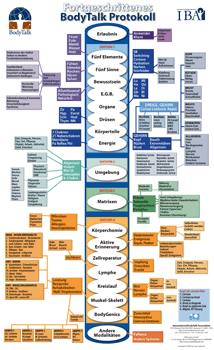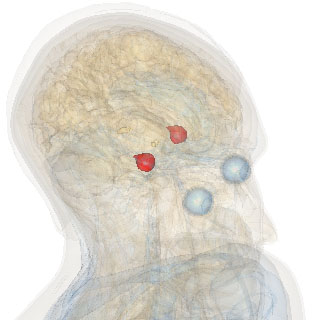Philosophy
Innate
Protocol and Procedure
BodyTalk vs Reiki
Amygdala
Videos
The BodyTalk Philosophy
Communicate - Synchronize - Balance
It could be for years, that the body has tried to tell something, pointing to problems. With the BodyTalk practitioner and his query of the BodyTalk protocol the body has found someone who listens and can give support.
The BodyTalk practitioner is like a conductor. For him poor health status is a sign, that the body's innate wisdom needs support for healing, to keep synchronicity in the body. The BodyTalk practitioner askes the innate wisdom using biofeedback (muscle testing), to establish the bodyparts, which are unsatisfactory linked and have poor communication. The innate wisdom will also tell via biofeedback, which priorities should be set to reestablish communication between all the systems and parts of the bodymind. The practitioner addresses the parts that need to be linked, touches them or asks the client to touch them. Meanwhile the practitioner is tapping on the head and sternum (heart) to facilitate the linkage and store it. This will support the body's innate wisdom and the self-healing capabilities on all levels - physically, mentally, emotionally and spiritually. It is not necessary to mentally grasp or understand the (re-)established links.
▲ Top of Page
What is »Innate«?
In the BodyTalk System the term innate describes the animating principle that directs the bodymind's impulse towards healing. When the intellect defers to this self-determining principle, on an intuitive level we tune into the deeper wisdom of the bodymind. The practitioner can then use the BodyTalk techniques according to the directions of innate. BodyTalk then serves as a medium for better aligning the client's physical, mental and emotional systems with naturally occurring healing processes. This enhances and accelerates the bodymind's ability to heal itself.
▲ Top of Page
Protocol and Procedure
- Find out which item/destination is the priority
- Find out how much detail we need to know about the priority destination
- Find out if there are other destinations that need to be part of the link
- Find the appropriate level of detail for those destinations
- Determine if any special considerations for balancing (e.g. breathing)
- Tell us when we are ready to »tap out«
- Tell us where to find the next priority for linking
- Tell us when to end the session
Example

- Permissions? NO
- EGB? NO - Organs? YES - Details? YES - More Specific? YES - Lungs? NO - Heart? NO - Liver? YES - Further Details? NO
- Link? YES
- Within Organs? NO - Endocrines? YES - Details? YES - More Specific? YES - Pineal? NO - Pituitary? NO - Thyroid? NO - Thymus? NO - Pancreas? YES - Details? NO
- Link? YES
- Within Endocrine? YES - Details? YES - More Specific? YES - Pineal? NO - Pituitary? NO - Thyroid? NO - Thymus? NO - Pancreas? NO - Adrenals? YES - Details? YES - More Specific? YES - Bilateral? NO - Right? NO - Left? YES - Further Details? YES - More Specific? NO
- Definition? YES - About Left Adrenal? NO - About Link? YES - Physiology? YES - Sugar metabolism? YES - Details? NO
- Further Definition? YES - Physiology? NO - Other Systems? NO - Emotion? YES - Anger? YES - Details? NO
- Further Definition? NO
- Further Details? NO
- Link? NO
- Implementation? YES
- Tap Out? YES
- Same Link still Priority? NO
- Liver Priority? NO
- Priority within Organs? NO
- Priority Forward? YES ...
Yes or No?
Dr. Don Kaimi Pilipovich about the yes/no question»There is a need to have humility in our sessions, and that it is our ability to be truly humble that opens us to greater clarity.
When you are asking your yes/no questions you are not really testing anything or anyone, you are using a tool to access intuitive answers about the client. Your answers are always somewhat suspect, because they come through your filters, your ability to be present, and your ability to ask the right questions. Until you accept this subjectivity, your answers may well be dangerous - because if you think you are testing and getting valid answers you might prescribe or give advice outside your scope of practice.
I actually find that once you are really clear that you are asking your own innate intuitive process you relax and become more present. If you are in this state clients don't ask many questions. With new clients I recommend asking questions out loud for part of the first session so they get the idea that there is a methodical process, then simply mention that the process goes faster and easier if you ask the questions quietly.«
BodyTalk vs Reiki
BodyTalk and Reiki are two modalities to strengthen and harmonize body energies. Being very different in methodology both are yet wonderful examples of uninvolved interaction. The practitioner acts as a medium, and practitioner and client let a treatment simply happen.
Reiki is simple, manifests as universal energy, cannot be controlled and can be directly applied for self-treatments and treatments of others after a Reiki master initiates someone to Reiki. The energy goes to where it is needed most, despite any intent the practitioner may have.
In BodyTalk there are NO - initiations. BodyTalk is search for priorities. What needs addressing? The innate wisdom of the bodymind (the manifest consciousness of the client in talk with the manifest consciousness of the practitioner) tells which rigidity or state of dis-ease is ready to fall away, and it will lead the practitioner to the required links. Self treatments are possible in Bodytalk, however not so efficient, if specific links are to be brought up. One could support himself by pragmatic execution for example of essential general balances.
In both BodyTalk and Reiki it is not the ego of the practitioner that is causing results, nor is it the such called »focus«, better to be named intention. True focus means being present to what is NOW, and to let happen whatever the treatment is affecting and effecting. Then, anything can result and nothing may result.
▲ Top of Page
The Amygdala

Amygdala (red)
Content by © BodyParts3D/Anatomography
licensed under CC-BY-SA-2.1-jp
Many of us have resigned to stress as the inevitable, unwelcome companion in modern daily life. Is it normal to overreact and go into panic mode when a deadline is near? Is it normal to ignore problems in relationships and suffer from anger or worry? This is normal isn't it?
There is a part in our brain the size of an almond, called the amygdala, which is responsible for our fight or flight mechanism since prehistoric times, when we had to decide whether to fight or run away from a tiger in front of us. At that time the amygdala was working well, and after escaping from the tiger, in the evening we could sit around the campfire and laugh about it, because the amygdala had relaxed and reset itself.
Nowadays stresses are of a different kind, and besides fight or flight we can and often choose a third option, which is more damaging to our bodies. This is to freeze, and among all this is the most harmful choice.
Because the amygdala is bombarded with constant signals of danger, but there is no real response. Watching TV this is even trained on a subtle level, when some armed forces in the attempt to gain control start screaming »freeze«. This builds great pressure, without the chance to relax and reset. The body is wearing out, like a car that is driven with full throttle and tightened handbrake at the same time.
Damage to the amygdala leads to inappropriate behavior, unnecessary anxiety or excessive aggression. In the permanent need for protection the adrenal glands are in full swing all the time, to supply enough adrenaline and cortisone for whatever threats might be around. The stress turns inwards because there is neither fight nor flight. This creates new health problems and worsens the already existing ones: headaches get stronger and more frequent, etc.
In BodyTalk there is a simple 2 minutes technique I teach to every client, so he can perform it on a daily basis. This is the Cortex balance and it serves to relax and reset the amygdala. The cortex balance also improves the communication between the left and right brain hemisphere of the brain, see the video below.
▲ Top of Page
Bodytalk Videos
More videos at the International Bodytalk Association
- BodyTalk Overview - General overview of the BodyTalk System.
- What is BodyTalk? - About how and why this consciousness based health care system sets itself apart from other modalities and why it is so effective.
- Concept of Diagnosis - Diagnosis is more then just a label. John Veltheim discusses the need for a true and complete diagnosis that looks at the root of the problem, not just the superficial symptoms, and how The BodyTalk System achieves this.
- Innate Wisdom - Innate Wisdom and how it can be used to help identify what's going on in the body. The dynamic of becoming in tune with Innate, and the important role Innate plays in BodyTalk.
- Use of Intuition - Exploring the different uses of intuition in the context of BodyTalk.
- The Intuitive Process - This process can be used with the innate wisdom to identify problems in the body. With real world examples to explain and describe the intuitive process.
- Consciousness - Description of consciousness. How science, in particular Quantum Mechanics, is one of the fundamental bases of BodyTalk.
- Consciousness Based Healthcare - The downward causality model. The BodyTalk system can be understood as consciousness based healthcare working on supramental and mental levels but also on the vital body and physical body.
- Principles of Consciousness - Standing waves, morhogenic fields, electromagnetic fields, the power of observation, probabilities and possibilities. How the BodyMind Complex, held together by consciousness, can effectively be treated with BodyTalk.
- Access Public Lecture - BodyTalk Access provides the layperson with a simple set of energy-based health care techniques.
